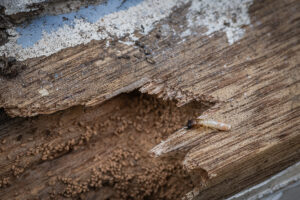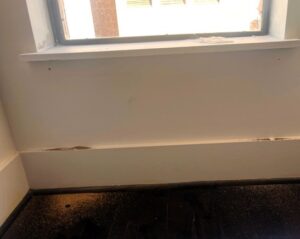Introduction to Drywood Termites
Drywood termites are a type of termite that infests dry wood. They form colonies inside dry wood above the ground and can establish colonies in wooden structures and furniture. They are social creatures and live in groups ranging in size from a few hundred to several thousand individuals.
Unlike subterranean termites, drywood termites do not build mud tubes, making them harder to detect. They do not require contact with soil to survive and get the moisture they need from the wood they digest. Drywood termites prefer to nest under wooden roof shingles, eaves, or siding. If left unchecked, they can cause significant damage to the structure of a building over time. Treatment for drywood termites usually involves fumigation or localized treatment of infested areas.
How Destructive are Drywood Termites?
Drywood termites can be incredibly destructive, causing significant damage to homes and other wooden structures. The financial impact of drywood termite infestations is substantial, especially when considering the cost of repairs, treatments, and preventative measures.
Most homeowner’s insurance policies do not cover termite damage. This lack of coverage means that all costs related to termite damage and treatment often fall entirely on the homeowner, further amplifying the financial burden. Drywood termites can go undetected for years because they live inside the wood they infest without needing soil contact. This allows them to cause significant damage before homeowners realize there is a problem.
Nationwide, termites cause over a billion dollars in damage annually-more than all tornadoes, hurricanes, and windstorms combined. Because they nibble away slowly from the inside, damage can be very extensive before it’s noticed. It’s not unusual for a termite to feast on a building throughout a life span of 15 years the queen can live and produce eggs for up to 50 years. Undetected and untreated, termites can severely damage and, in time, destroy a home. (Source: Texas Department of Agriculture https://texasagriculture.gov/Regulatory-Programs/Pesticides/Structural-Pest-Control-Service/Termite-Fumigation-Applications/Termite-FAQs )
Signs of Drywood Termite Infestation
Drywood termites are a common pest that can cause significant damage to wooden structures. Here are some signs that may indicate the presence of drywood termites:
1. Frass (Termite Droppings):
Drywood termites push their droppings, known as frass, out of small holes near the infested wood. These droppings look like tiny, hexagonal pellets and may appear in small piles beneath wooden structures or furniture.
2. Damaged or Hollow-Sounding Wood:
Drywood termites eat wood from the inside out, leaving a thin veneer on the surface. Tapping on the wood might produce a hollow sound, indicating that termites have tunneled inside.
3. Visible Tunnels or Galleries in Wood:
If you break open the wood, you might see tunnels or galleries with a smooth, sandpaper-like appearance. This is a clear sign of termite activity.
4. Swarming:
During warm weather, reproductive termites (called alates or swarmers) leave their colony to start new ones. If you see winged termites inside your home, especially near windows or lights, it could indicate a drywood termite infestation.
5. Discarded Wings:
After swarming, drywood termites shed their wings. Finding piles of discarded wings near windows, doors, or other entry points indicates that termites may have entered your home.
6. Small Holes in Wood:
Drywood termites create tiny exit holes in wood to push out their frass. These holes are usually small and round, about 1-2 mm in diameter.
7. Buckling or Blistering Wood:
As termites eat through wood, it can cause the surface to buckle or blister. This damage may look like water damage but is caused by termite activity underneath the wood surface.
8. Hard-to-Open Windows or Doors:
As drywood termites tunnel through wooden frames, the wood may warp, making it difficult to open or close windows and doors.
9. Sounds in Walls:
In some cases, you may hear faint clicking sounds coming from the walls. This is caused by the termites chewing on wood or shaking their bodies to signal danger within the colony.
Below are photos showing signs of drywood termites. Piles of termite frass beneath wooden structures both inside and outside of the home:



Preventative Measures
To prevent drywood termite infestations, it’s important to take certain preventative measures. Here are some tips:
1. Seal and Finish Wooden Structures
Ensure all wooden structures, including furniture, are properly sealed and finished to prevent easy access for drywood termites.
2. Inspect and Seal racks
Regularly inspect and seal any cracks or openings in wooden structures, as these can provide entry points for termites.
3. Store Firewood Away from Structures
Keep firewood and other wooden materials stored away from the main structure of your home or building.
4. Maintain Proper Ventilation
Maintain proper ventilation in attics, crawl spaces, and basements, as drywood termites are attracted to moist environments.
5. Schedule Regular Professional Inspections
Schedule regular professional inspections for early detection of any potential termite activity.
Following these preventative tips can reduce the risk of a drywood termite infestation and protect your property from potential damage.
How to Treat for Drywood Termites
Fumigation is the recommended treatment for drywood termites because it effectively penetrates the wood and reaches the hidden colonies of termites. This method involves enclosing the infested structure in a tent and introducing a gas, such as sulfuryl fluoride, to exterminate the termites.
Fumigation effectively eliminates widespread infestations, as it can reach areas where localized treatments may not be as practical. Additionally, fumigation can provide thorough coverage, ensuring that the entire infested area is treated.
Drywood termites pose a serious threat to property, and the costs associated with their infestations reflect their potential for destruction. Vigilance is crucial for protecting your most valuable asset, your home, from drywood termites.

Fumigation in progress
Comprehensive Termite Inspection and Treatment Services
A professional termite inspection is crucial for accurately diagnosing and treating termite infestations. Coastal Fumigators offers comprehensive inspection and treatment services to effectively address drywood termite infestations. Schedule your free inspection online or call 713-862-8224 to protect your property from potential damage.




